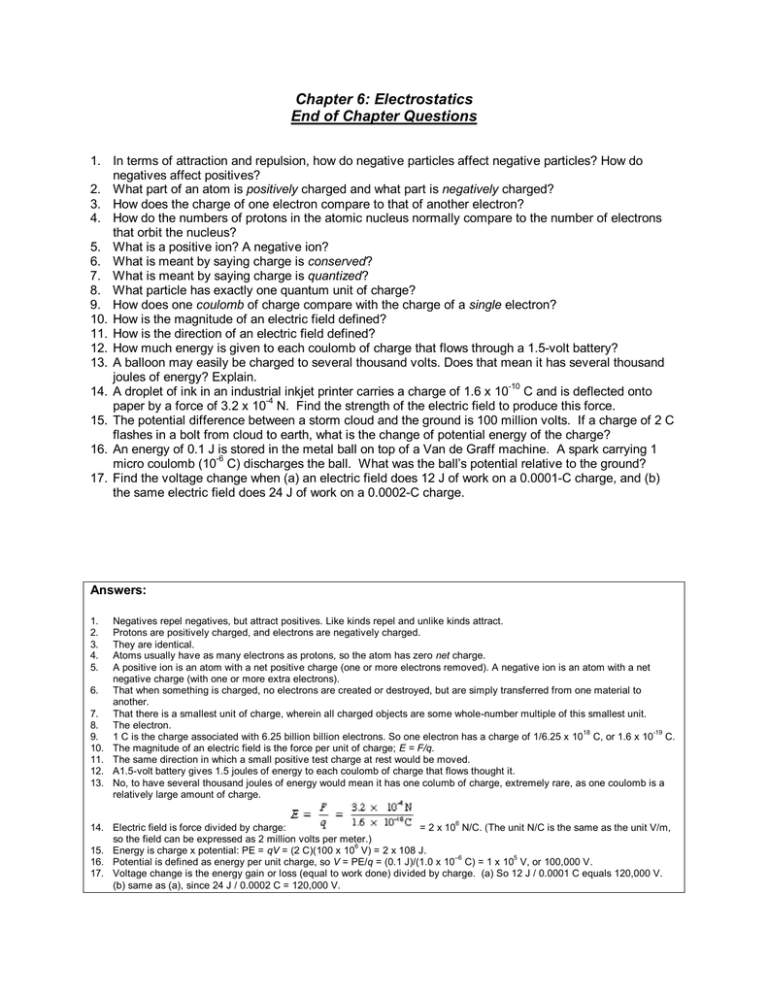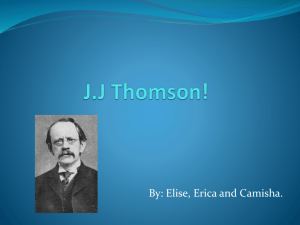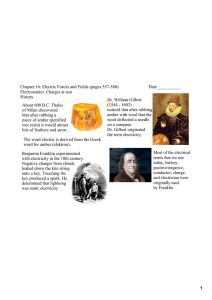Chapter 6: Electrostatics End of Chapter Questions
advertisement

Chapter 6: Electrostatics End of Chapter Questions 1. In terms of attraction and repulsion, how do negative particles affect negative particles? How do negatives affect positives? 2. What part of an atom is positively charged and what part is negatively charged? 3. How does the charge of one electron compare to that of another electron? 4. How do the numbers of protons in the atomic nucleus normally compare to the number of electrons that orbit the nucleus? 5. What is a positive ion? A negative ion? 6. What is meant by saying charge is conserved? 7. What is meant by saying charge is quantized? 8. What particle has exactly one quantum unit of charge? 9. How does one coulomb of charge compare with the charge of a single electron? 10. How is the magnitude of an electric field defined? 11. How is the direction of an electric field defined? 12. How much energy is given to each coulomb of charge that flows through a 1.5-volt battery? 13. A balloon may easily be charged to several thousand volts. Does that mean it has several thousand joules of energy? Explain. 14. A droplet of ink in an industrial inkjet printer carries a charge of 1.6 x 10-10 C and is deflected onto paper by a force of 3.2 x 10-4 N. Find the strength of the electric field to produce this force. 15. The potential difference between a storm cloud and the ground is 100 million volts. If a charge of 2 C flashes in a bolt from cloud to earth, what is the change of potential energy of the charge? 16. An energy of 0.1 J is stored in the metal ball on top of a Van de Graff machine. A spark carrying 1 micro coulomb (10-6 C) discharges the ball. What was the ball’s potential relative to the ground? 17. Find the voltage change when (a) an electric field does 12 J of work on a 0.0001-C charge, and (b) the same electric field does 24 J of work on a 0.0002-C charge. Answers: 1. 2. 3. 4. 5. 6. 7. 8. 9. 10. 11. 12. 13. Negatives repel negatives, but attract positives. Like kinds repel and unlike kinds attract. Protons are positively charged, and electrons are negatively charged. They are identical. Atoms usually have as many electrons as protons, so the atom has zero net charge. A positive ion is an atom with a net positive charge (one or more electrons removed). A negative ion is an atom with a net negative charge (with one or more extra electrons). That when something is charged, no electrons are created or destroyed, but are simply transferred from one material to another. That there is a smallest unit of charge, wherein all charged objects are some whole-number multiple of this smallest unit. The electron. 18 -19 1 C is the charge associated with 6.25 billion billion electrons. So one electron has a charge of 1/6.25 x 10 C, or 1.6 x 10 C. The magnitude of an electric field is the force per unit of charge; E = F/q. The same direction in which a small positive test charge at rest would be moved. A1.5-volt battery gives 1.5 joules of energy to each coulomb of charge that flows thought it. No, to have several thousand joules of energy would mean it has one columb of charge, extremely rare, as one coulomb is a relatively large amount of charge. 6 14. Electric field is force divided by charge: = 2 x 10 N/C. (The unit N/C is the same as the unit V/m, so the field can be expressed as 2 million volts per meter.) 6 15. Energy is charge x potential: PE = qV = (2 C)(100 x 10 V) = 2 x 108 J. –6 5 16. Potential is defined as energy per unit charge, so V = PE/q = (0.1 J)/(1.0 x 10 C) = 1 x 10 V, or 100,000 V. 17. Voltage change is the energy gain or loss (equal to work done) divided by charge. (a) So 12 J / 0.0001 C equals 120,000 V. (b) same as (a), since 24 J / 0.0002 C = 120,000 V.



